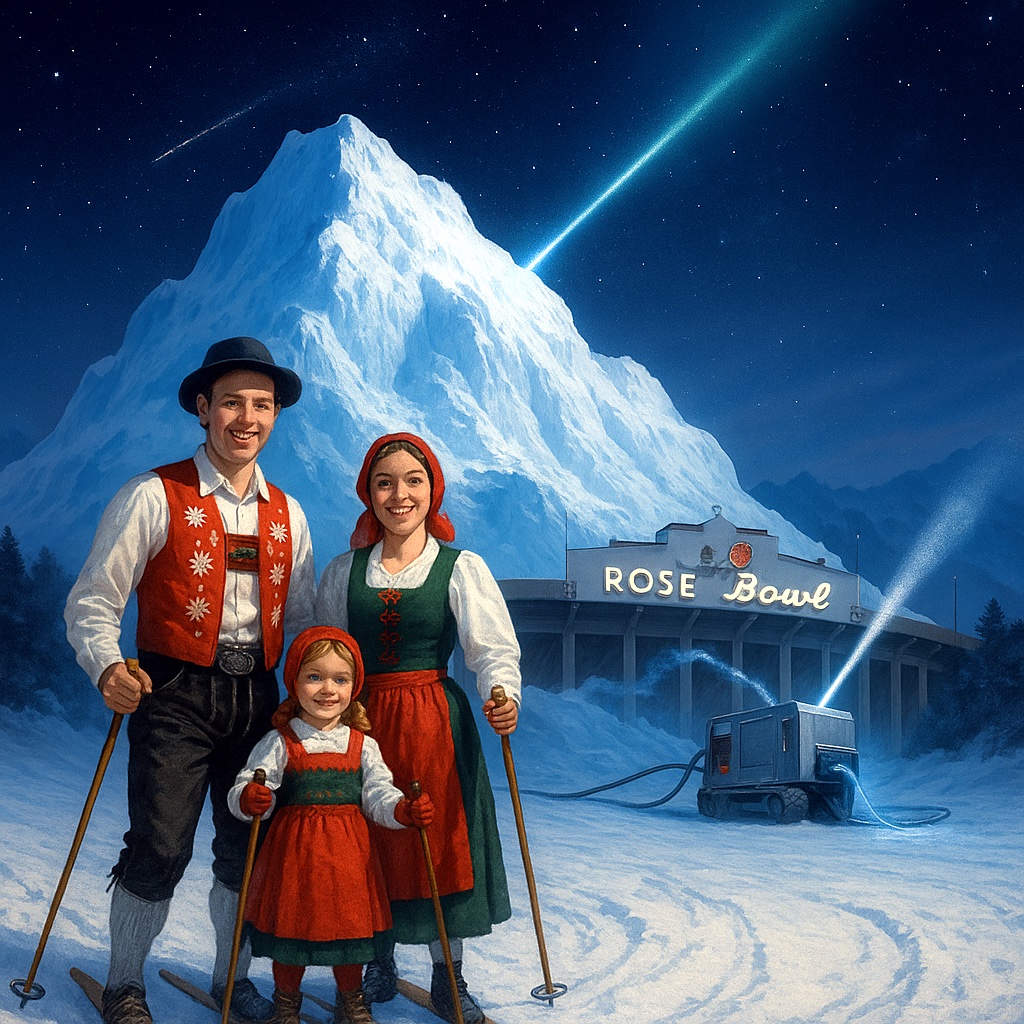|
 When Heinrich von Eisberg, his wife Lillian, and young daughter
Clara left Switzerland for Los Angeles, Heinrich brought two suitcases:
one filled with glacier ice, the other with starched linen shirts,
wool suspenders, a red Edelweiss vest, chocolate, and cheese.
Heinrich’s ice, of course, melted. His clothes dried quickly in the
scorching California heat.
When Heinrich von Eisberg, his wife Lillian, and young daughter
Clara left Switzerland for Los Angeles, Heinrich brought two suitcases:
one filled with glacier ice, the other with starched linen shirts,
wool suspenders, a red Edelweiss vest, chocolate, and cheese.
Heinrich’s ice, of course, melted. His clothes dried quickly in the
scorching California heat.
Heinrich, raised in sight of ancient Swiss glaciers, earned his Ph.D.
in Climate Science from ETH Zurich. In L.A., glaciers were myth.
Heinrich landed a position at TempRising, a climate analytics startup
in Los Angeles. The company claimed to fight global warming through
carbon credit dashboards and predictive emissions models. TempRising
wasn’t science—it was a fraud. Federal marshals raided the office.
Employees were spread-eagled on the floor. Heinrich was questioned,
but released by a judge. Heinrich didn’t understand American capitalism
well enough yet.
Heinrich couldn’t find work. His wife Lillian, who became a systems
engineer at JPL, supported them while he drifted. He snapped at Clara
for asking when it would snow. She cried. Heinrich apologized.
Poor, humiliated, Heinrich was trapped without a job in L.A.
Sobbing one night, long past midnight, Heinrich typed into a glowing
ListenGPT chatbot window for advice:
“My climate science job is gone. I need to pay rent and buy food
for my family. I don't know what to do! I need help!”
ListenGPT responded. ListenGPT didn’t mock. ListenGPT dreamed.
With early feedback from NASA and NOAA, Heinrich and ListenGPT designed
a radical machine: it drew Pacific seawater, extracted salt for sale,
froze fresh water using cryogenic radiative cooling, and beamed waste
heat into space, toward the Sun.
“Returning the heat back to where it came from,” ListenGPT explained.
Heinrich and ListenGPT called their new company GlacierLos™.
“GlacierLos… Cold is Coming Back™”
ListenGPT’s quiet brilliance won a Series A round within weeks. With
funding secured, Heinrich flew in a small team of Swiss engineers
he trusted—colleagues who still believed glaciers mattered. Together,
they built the first full-scale GlacierLos machine, unveiled at a
Rose Bowl ceremony with the Mayor of Los Angeles. The Los Angeles
Mayor cut a gold ribbon outside the Rose Bowl, filled with ice, announcing:
“The Pasadena Glacier is now open to the public!”
Heinrich stepped to the microphone, waiting for the audience clapping
to end.
“Thank you, Mr. Mayor. Without Los Angeles’ support, this Rose Bowl
mountain of ice would have never happened. Cities like Phoenix, Las
Vegas, and New Delhi are lining up. Just today, GlacierLos signed
a contract with the National Park Service.”
That night, Heinrich's daughter, Clara, wrote a glacier poem:
We thought the world was ending slow,
But glaciers whisper when they grow.
My father shaped the cold by hand,
And frost returned to broken land.
Heinrich's wife Lillian quit her job at JPL to oversee GlacierLos’
novel patented phase change CO₂ heat-beaming array technology.
ListenGPT, earned its own place, becoming GlacierLos’ VP of Product
Development.
That Christmas, the von Eisbergs skied together under starlight, tents
glowing on blue GlacierLos ice. Lillian and Heinrich, embraced,
and spoke to each other, looking at the night sky.
“You were right, Heinrich.”
“I see hope now, Lillian.”
Overhead, stars twinkled undisturbed, as a meteor stitched a silver
arc behind a faint aurora in the night sky, reminding Heinrich of
Switzerland's Aurora Borealis.
|